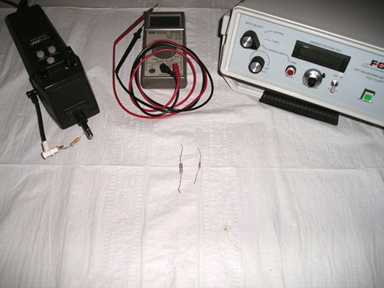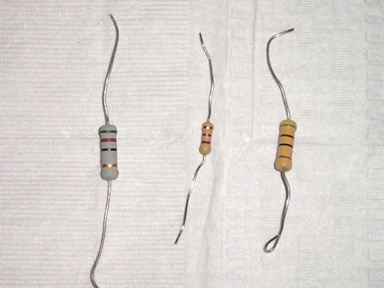Carbon composition resistors work very well under pulsed conditions, but are getting difficult to obtain. Results of tests run on several modern film resistors using high voltage pulses are presented. For the cases tested, the resistors performed well with no damage. Figure 1 shows the test setup. High voltage pulses with a duration of about 100 ns were applied from a Mini-Zap ESD simulator in contact discharge mode and a Fischer Custom Communications TG-EFT high voltage pulse generator. The TG-EFT waveform simulates electrical fast transients, EFT, found on power lines. The wave shape is similar to ESD but without the leading peak.

Figure 1: Test Setup Including Mini-Zap ESD Simulator and TG-EFT High Voltage Pulse Generator
Carbon composition resistors are the resistors of choice for pulsed applications but are becoming difficult to find, especially in electronic stores. I need a supply of resistors that will not be damaged by ESD or EFT waveforms so I decided to test several resistors from a local electronic store.
Several metal and carbon film resistors ranging in value from 51 Ohms (one Watt) to 4700 Ohms (1/2 Watt) were tested. Figure 2 shows a 51 Ohm 1 Watt Carbon Film resistor connected to the Mini-Zap for testing. Also tested were a 51 Ohm 1 Watt metal film resistor, 470 Ohm 1/2 Watt “film” resistor, a 1000 Ohm 1/2 Watt “film” resistor, and 4700 Ohm 1/2 Watt “film” resistor. The TG-EFT generator was used up to 2000 Volts followed by the Mini-Zap at 10,000 Volts.

Figure 2: 51 Ohm Film Resistor Stressed by ESD Simulator
Figure 3 shows three of the resistors tested including a 51 Ohm 1 Watt Metal Film Resistor, a 4700 Ohm 1/2 Watt “Film” Resistor, and a 51 Ohm 1 Watt Carbon Film Resistor. The 51 Ohm resistors carry more peak current from the Mini-Zap or TG-EFT, but the 4700 Ohm resistor sees more voltage stress. It was not clear before the testing started which ones would be more susceptible to damage. In the past, I have been able to destroy 1 megohm resistors used in ESD control by using an ESD simulator set to voltages on the order of 10 kV.Surprisingly enough, all the resistors survived many tens of pulses with no change in resistance as measured on an accurate digital multimeter capable of detecting a change of 1 Ohm out of 1000 Ohms. This is likely due to the fact that these were all 5% resistors and as such were not likely laser trimmed. Laser trimmed 1% resistors often do not survive high peak value pulses because the current concentrates around the end of the laser cut and the resistance exhibits a cumulative change over many pulses often ending in an open circuit or occasionally even a short circuit. The result would also have likely been different if simulated 6 kV lightning pulses were used as these pulses are measured in tens and hundreds of microseconds. Longer length pulses, such as lightning pulses, are much more likely to damage resistors.

Figure 3: Test Resistors (from left to right: 1W-51 Ohm Metal Film Resistor, 1/2W-4700 Ohm “Film” Resistor, and 1W-51 Ohm Carbon Film Resistor)
Summary
All of the resistors tested survived many tens of pulses at 10,000 Volts from a Mini-Zap ESD Simulator. This suggests that modern film resistors in values up to 4700 Ohms and power levels as low as 1/2 Watt that are not laser trimmed are suitable for use in applications where they are exposed to ESD and EFT stresses. To be safe, you should check any resistors you plan to use this way with an ESD simulator as common resistors are not specified for such use.
Equipment related to this Technical Tidbit:
Thermo Scientific Mini-Zap ESD Simulator
Fischer Custom Communications TG-EFT high voltage pulse generator
For more Technical Tidbits, please visit Doug’s site, http://emcesd.com. ![]()
 |
Douglas C. Smith Mr. Smith held an FCC First Class Radiotelephone license by age 16 and a General Class amateur radio license at age 12. He received a B.E.E.E. degree from Vanderbilt University in 1969 and an M.S.E.E. degree from the California Institute of Technology in 1970. In 1970, he joined AT&T Bell Laboratories as a Member of Technical Staff. He retired in 1996 as a Distinguished Member of Technical Staff. From February 1996 to April 2000 he was Manager of EMC Development and Test at Auspex Systems in Santa Clara, CA. Mr. Smith currently is an independent consultant specializing in high frequency measurements, circuit/system design and verification, switching power supply noise and specifications, EMC, and immunity to transient noise. He is a Senior Member of the IEEE and a former member of the IEEE EMC Society Board of Directors.His technical interests include high frequency effects in electronic circuits, including topics such as Electromagnetic Compatibility (EMC), Electrostatic Discharge (ESD), Electrical Fast Transients (EFT), and other forms of pulsed electromagnetic interference. He also has been involved with FCC Part 68 testing and design, telephone system analog and digital design, IC design, and computer simulation of circuits. He has been granted over 15 patents, several on measurement apparatus. Mr. Smith has lectured at Oxford University, The University of California Santa Barbara, The University of California Berkeley, Vanderbilt University, AT&T Bell Labs, and internationally at many public and private seminars on high frequency measurements, circuit design, ESD, and EMC. He is author of the book High Frequency Measurements and Noise in Electronic Circuits. His very popular website, http://emcesd.com (www.dsmith.org), draws many thousands of visitors each month to see over 150 technical articles as well as other features. He also provides consulting services in general design, EMC, and transient immunity (such as ESD and EFT), and switching power supply noise. His specialty is solving difficult problems quickly, usually within a couple of days. His work has included digital and analog circuits in everything from large diesel powered machinery to IC chip level circuits. His large client base includes many well known large electronic and industrial companies as well as medium sized companies and start-up companies. |
